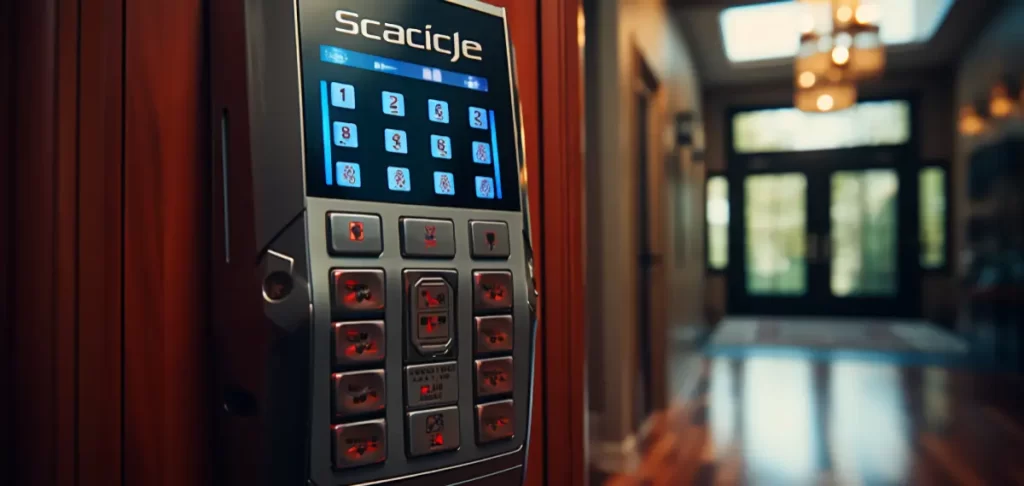
In today’s age of smart homes, one question that often pops up is: Will my smart lock still function during a power outage?
As a woman living alone, I’ve delved deep into understanding the intricacies of smart home devices, especially smart door locks. Let’s explore this together.
The Basics Of Smart Locks
Smart door locks have become an integral part of many smart homes. These devices offer convenience, security, and a touch of modernity. But how do they really work?
Most smart locks operate using battery power or an electrical connection.
Battery-powered locks rely on AA batteries or rechargeable batteries, while electric locks need a continuous power supply.
The good news is that many of these locks have a backup battery system to ensure they function even during electric outages.
Power outages can be a real concern for smart homeowners. With so many devices dependent on electricity, what happens when the lights go out?
The Vulnerability Of Modern Homes
In our increasingly connected world, homes are filled with devices that rely on a steady power supply.
From smart refrigerators to voice assistants, these devices enhance our daily lives but also make us more vulnerable during power interruptions.
A power outage can disrupt not only our comfort but also essential security systems, including smart locks.
Smart Locks: Designed For Resilience
Thankfully, most smart door locks are designed with power outages in mind.
They have a battery backup, ensuring that the locking mechanism remains operational.
This backup system is crucial because, during a power outage, the last thing any homeowner wants is to be locked out of their own home or, worse, be unable to secure their home from potential threats.
Battery Life And Maintenance
The battery life of these backup systems varies depending on the model and usage.
Some can last for months, while others might need more frequent replacements or recharging.
It’s essential for homeowners to be aware of their smart lock’s battery life and have a routine for checking and replacing batteries as needed.
Real-time Notifications
Additionally, some smart locks send battery notifications to your mobile device, giving you peace of mind.
These notifications can alert you when the battery is running low, ensuring you’re never caught off guard.
In some advanced models, the smart lock can even differentiate between a power outage and a simple battery drain, providing more specific alerts.
Integration With Other Smart Devices
Many smart locks are part of a broader smart home system.
During a power outage, integrated systems can work together to ensure safety.
For instance, if a smart security camera detects movement outside during an outage, it can communicate with the smart lock to ensure the doors remain locked.
Similarly, smart home hubs can be programmed to send alerts or sound alarms if there’s an attempt to tamper with the lock during a power failure.
Battery-Operated Smart Locks
Battery-operated smart locks are a popular choice in the market today. They offer the convenience of not being tied to your home’s electrical system.
These locks typically run on AA batteries or rechargeable battery packs.
The battery life can vary, but many of the best smart locks offer a long-lasting power source.
In addition, many smart locks have red light indicators or mobile app notifications to alert you when the battery is running low.
Electrically Powered Smart Locks
Electric locks, on the other hand, are connected to your home’s power supply.
They often come with features like Bluetooth connectivity, remote access, and integration with voice assistants like Amazon Alexa and Google Home.
The good idea here is to have a backup power source, like backup batteries or even solar power.
This ensures that in the event of an electric outage, your smart lock function remains uninterrupted.
Some smart locks even offer power loss recovery features, ensuring essential functions remain active.
Manual Override Features
While smart features are great, there’s something reassuring about having a physical key as a backup.
Many smart locks come with a mechanical key option, allowing you to manually override the electronic locking mechanism.
This is especially useful if there’s an issue with wireless communication, internet connection, or battery power.
It’s always a good idea to familiarize yourself with this feature and keep a physical key handy.
Tips For Homeowners
For those embracing the keyless lifestyle, it’s essential to stay informed and prepared. Here are some pointers:
- Regular Maintenance: Check your smart lock’s battery regularly and consider using lithium batteries for longer life.
- Backup Power: Invest in backup power sources like rechargeable batteries or surge protectors.
- Stay Updated: With the plethora of smart home products available, from smart thermostats to smart garage doors, it’s crucial to keep your devices updated.
- Integration: Ensure your smart lock integrates well with other devices like smart cameras, smart security systems, and voice assistants.
Personal Reflection
Living alone has made me more conscious of my home’s security.
Investing in smart home devices, especially a reliable smart door lock, has given me immense peace of mind. Knowing that my home is secure, even during power outages, is truly priceless.
Final Thoughts
In the world of smart home automation, ensuring security during power outages is paramount.
While smart lights, smart plugs, and smart thermostats are fantastic additions, the security of your front door is crucial.
Thankfully, with the advancements in smart lock technology, homeowners can rest easy knowing their homes remain secure, even when the power goes out.
This article has affiliate or sponsored links. If you buy something through those links I may earn a small commission. This won’t cost you extra. I only recommend things I really think are good, not just to make money. For more details, see my Affiliate Disclaimer.
